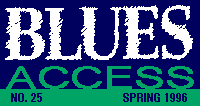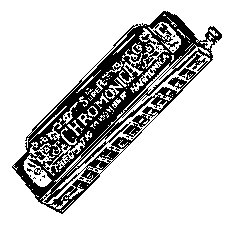

 | ||
| The Doctor is In! |

Dear Dr. Harpo,
I'm totally confused by chromatic vs. diatonic harmonicas. I can't make much sense out of those diagrams in the catalogs that tell you what's what. I think that I want to start playing chromatic, as I like the sound, but they're expensive, so I don't want to buy the wrong one. Help! Remember, I don't read music, so don't get too technical, OK?
Diatonically yours,
Chip Leavitt
Passaic, N.J.
The man who thinks in italics pauses, absent-mindedly taps a fresh Eve menthol on his thumbnail, lights the filtered end with his Scripto, the one with the fishing lure swimming around in the lighter fluid, drags deep and manly, and smiles. Could life be sweeter, he muses? Not without insulin.
Chip,
Don't agonize. Use traditional chromatics for thirdposition stuff and minor key songs where a diatonic just doesn't have the right notes. Carey Bell even plays one through a Leslie unit, so it really brings out the organlike tone of a chro. Get one in "C," and you'll be in good shape for the majority of tones that you want to accompany on recordings.
I recommend a Hohner 64 Chromonica, a beautiful instrument that is unfortunately pretty pricey. Its little brother, the 270 Super Chromonica, is a cheaper and very cool alternative, and is even available in sterling silver if you just hit the lottery or feel like you're kissing a De Soto if you play chrome harps.
The 270 is also available in "tenor" tuning, which pitches the whole horn an octave lower, losing the Toots Thielemans register that most amplified players can't hear any more anyway, but gaining Sonny Boy register for chugging along on some yard-long brass reeds down low.
Other chromatics exist, such as the Koch harmonica, a hybrid diatonic pair with four reed plates and a slide button, "C" and "C#," stacked on top of each other, with wind savers for that distinctively chromatoid sound, but the same pattern of notes as a diatonic. Easy to play, as done by Little Walter on "You're Gonna Miss Me When I'm Gone."
Walter also recorded frequently with the Hohner 364S, a budget alternative to a true chromatic, with only two reed plates for blow and draw, but pitched in the pattern of notes on a traditional chromatic. They're cheap, loud, and a gas to play. They even sound like a chromatic but don't have any wind savers or valves. I'd recommend that you start with this one before you invest heavy in a big chromatic.
Donning his titanium codpiece, the Source of All That's Wind prepares to take a shot to the keepers.
Dear Dr. Harpo,
I'm mildly pissed. In the last issue of BLUES ACCESS, you sounded off about your list of all-time-best harp players, and I know that Charlie Musselwhite dusts everybody that you mentioned. Haven't you heard of him? Maybe you do live under a street sweeper!
Bill Fernandez
Fremont, California
Moderately pissed himself, Old Red Eyes slugs the corner of his very chilled Night Train, which promptly slugs him right back into the nurturing folds of his Barcalounger. He rallies.
Hey Bill,
Take the jitter sander out of your overalls. I have been a fan of Mr. M. since Stand Back! days, and I agree, his work has always been beyond compare. I especially admire his 3rd position workout on "Christo Redentor," a harp classic, and his live and recorded work lately is in another dimension from what most people know as harp playing. The people that I mentioned were the players that are influential in the sense that they are commonly imitated.
What's that? Another voice hallos, a plaintive cry for help, temporary or permanent.
Dear Dr. Harpo,
Do you know about any good books for harp players that talk about and show pictures of various mikes and old amps? I keep seeing all of those funky old things at swap meets, and I don't know if they're gems or junk. I saw a guitar player buddy of mine had a book like that on old guitars, and someone ought to write one, if it doesn't exist.
Thanks!
Doug Porter
Concord, MA
The Human Catalog takes his attention from the J.C. Whitney ad for "Turn-Signal Barbie," making a note to measure the rear deck of the Borg Ward for clearance on those snazzy flashing Dagmars, and parts the pom-poms obscuring the windshield of his mind. The answer, please.
Dear Doug,
Dry your palms and relax; you're in luck. Kevin's Harps (1-800-274-2776), the guy with the J.C. Whitney catalog on harpdom, is selling The Quest for Tone and Amplified Blues Harp by Pete Sheridan for $14.95. It's got three sections: one for mikes, one on amps, and one on effects, like echo and such.
In addition, it has page after page of antique ads for mikes, amps, harps and assorted harp arcana that's not only interesting to check out, but is a field guide for gigging among electronic rubble to unearth some gems. I like Pete's style, and share his prejudice in favor of old cheap and offbeat solutions to equipment needs. This is a must-read, as you can easily save many times the cover price on your next equipment purchase with the info in this book.
 |
 |